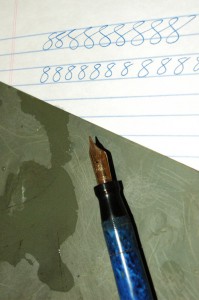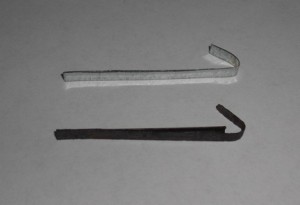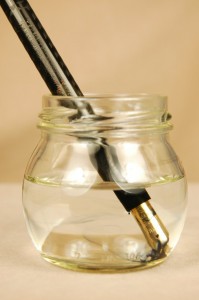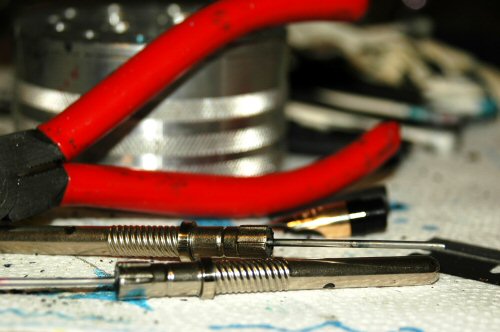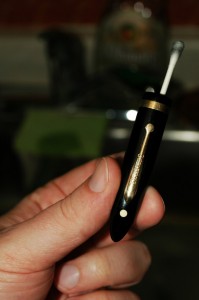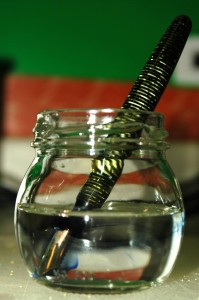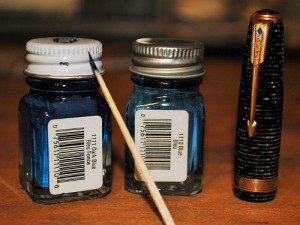
Use Testors paints to fill in the blue diamond of your Parker Vacumatic clips. Some clips have old paint that tells how dark you should repaint it. Testors 1111 Dark Blue paint is good for darker blue diamonds and 1110 Blue is good for lighter blue diamonds. I used the 1110 Blue on the Vac Major you see in this photo. Also shown is a toothpick I use for the painting process.
You have successfully put a new diaphragm into your Parker Vacumatic. The celluloid and gold trim gleam from expert polishing. Now, how do you go about making the finishing touch and repainting the old blue diamond in the clip?
Some clips still have their enamel…or at least some of it. Most these days, do not have it.
Some purists say you should never paint in the blue diamond. Other experts say it is no big deal.
Me, I like finishing the look of the pen as close to factory fresh as I can make it. If you have an ultra rare model with partial paint, perhaps you should leave it as is. But for most of the working pens I deal with, fresh paint won’t effect the value.
The big trick is finding the right color paint to get the blue diamond as close to accurate as possible.
Having spent all of my teen years as an avid model airplane builder, I ran straight to the nearest hobby shop to turn to trusty Testors paints. I took a handful of clips with me and began comparing and contrasting the paint options.
That is when I noticed not all blue diamonds in the Parker Vacumatic clips were the same. Some were lighter and some were darker blue. I let the remnant paint/enamel in the old diamond guide me. I finally settled on two Testors blue paints from their myriad shades.
If you look on the bar code sticker on the back of the paint bottle, you will notice the name of the color and a number. That color number should be universal in any Testors paint display.
For the lighter blue diamonds, I found that the 1110 Blue by Testors is a near perfect match. The next shade darker is the 1111 Dark Blue, which is a near perfect match for the darker blue diamonds. It sounds intuitive, but there are so many blues from which to pick.
Painting the diamond takes a steady hand and only a teeny-tiny amount paint. You can use a single-hair brush, but I find I prefer using a toothpick that I’ve whittled to an extra-fine point.
Dab in the paint until you have filled in the diamond. Use a magnifying glass to make sure you have filled in the corners. There is bound to be some spillage outside the raised lines of the diamond. I try to clean it up with the dry edges of the toothpick by rubbing a clean, dry edge of the toothpick along the edge of the diamond. If the paint gets down into the feathers of the arrow logo, a little paint thinner on a Q-tip can help get it out before it sets. Remember to make sure the Q-tip is not sopping wet with thinner, as spilling the thinner into the wet paint of the diamond can mess things up, too.
Best of luck on painting your diamonds blue!


 Shopping Cart
Shopping Cart









